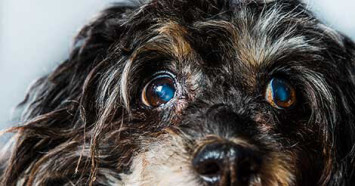
Finding out that your dog has gone blind can be one of the biggest heartbreaks for a pet parent. But that doesn’t mean it’s time to give up hope. Just the opposite. This is an opportunity for you to step up and help your dog continue their quality of life.
First off, how can you tell if your dog is going blind? Surprisingly, many dogs can mask the symptoms of vision loss for a long time. But, if you notice your dog is bumping into things or can’t locate things like their bed/toys it might be time to contact your vet. Dogs may also be reluctant to move or jump, avoiding steps or a jump onto the bed. It can be hard for pet parents to experience a dog who can’t make eye contact, or worse, is acting in an aggressive manner because they’re fearful and insecure.
You can help your dog adapt to their loss of vision. It may require a little extra vigilance and support on your part, but most dogs thrive in spite of their disability.
Avoid Moving Things Around
As much as possible, keep your home layout the same. Keep their food, water, and bedding in the same spots and be aware of any changes to the area. Even a different rug under their dishes can be disorienting.
Try to avoid moving furniture if possible. Some pet parents suggest applying a scent to the corners of furniture, so the dog might detect it. Others recommend having a sound (white noise, the tv, a radio) playing somewhere in the home to help dogs orient themselves. And be aware of their paths. Something as basic as a laundry basket or toy in their way can be a hazard for them.
Pet-proofing
Pet proof your home and yard. Make sure you have baby gates at stairways, both up and down, at least in the beginning. (You may need to coach your dog to get reacclimated to stairs, staying close by their side while be running around. If you haven’t already, crate training your dog might be safer and more reassuring to them, as it’s a smaller, more stable environment when you’re away.
Training Tips
Training can go a long way to help your blind dog be more at ease. Treats and a clicker will be your new go-tos, encouraging them to use their other senses when you praise them. The “stay” and “wait” commands will be very useful as you’re guiding them or helping them navigate, so work on those commands first, then consider adding in terms like “left,” “right,” or “stop.”
You might want to use a code to tell them when they’re being approached by a person, such as “say hi” or “make friends.” There are also bandanas or collars that alert strangers to the fact that your dog is blind, but be sure no one touches your dog without a heads up.
Exercise for Blind Pets
Encourage walks and exercise. Blind dogs do best in familiar terrain and areas with flat sidewalks. They should be on a loose leash as much as possible. Be aware that busy places can be really scary to a blind dog, so avoid crowds or chaotic dog parks. Opt for a game of tug of war or a treat-filled toy to offer them some enrichment at home.
Leaving Your Blind Pup Home Alone
If you must travel without your dog, consider having a sitter come to your home so that they won’t have to navigate a loud kennel or other unfamiliar territory while you’re gone. It never hurts to have a trusted friend learn your dog’s commands or routine in case you get called away in an emergency.
It’s important to keep talking to your dog. Sure, they can usually smell us, but our smell is on everything in the house too. Say their name, tell them what you’re up to while you make dinner, talk about your day. A blind dog finds a great deal of reassurance in hearing a familiar voice. You’ll find that, with a little patience and support, your dog will do quite well adjusting to their “new normal.”